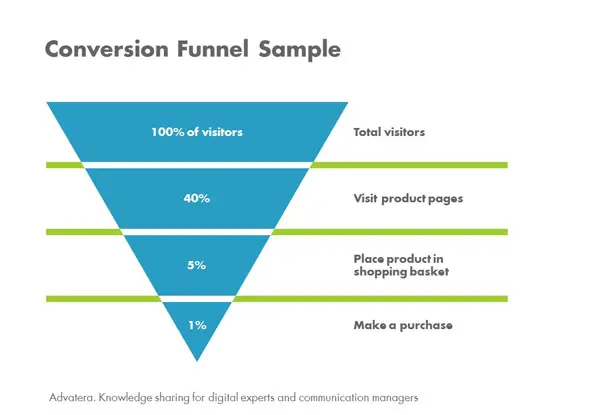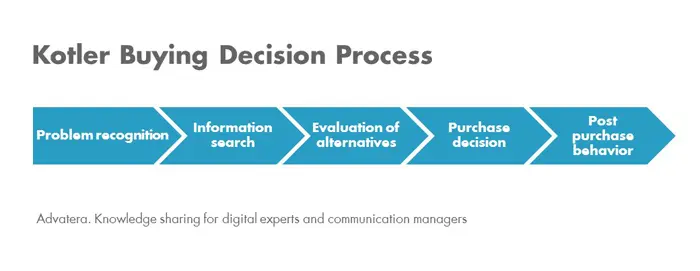When analyzing consumer behavior,
it’s not about filling a funnel. It’s about guiding the buyers through a journey,
said Erik Hartman at this year’s Digital Leadership Forum in Vienna.
Let’s take a closer look at the meaning behind his words and how we can improve our understanding of the buying process. Conversion funnels are an important marketing model, as they allow for easy tracking of the consumer buying process with statistical tools. They are often divided into different purchase steps, as in the graphic below:
However, the consumer decision making process is usually much more complex than can be adequately illustrated by the funnel model. Consumers look at competitors, compare prices and may get recommendations from other customers.
In addition, the conversion funnel ends with the customer’s purchase, overlooking the crucial post-purchase phase. It is during this phase that customers may need support, decide whether they are happy or unhappy with the product, review the product and recommend it to others – or don’t.
Depending on the product category, this phase is also important for winning recurring customers. The best tactics for generating high conversion rates through the funnel may not be the same tactics necessary to ensure that you have happy, long-term customers.
Customer Journey Mapping
Here, the more comprehensive customer journey mapping approach can help by paying attention to the post-purchase phase and its implications.
Depending on the involvement the customer has, the journey can be longer or shorter. For high involvement products like cars, it might be a long process consisting of the initial search for information, looking for alternatives and, finally, complex decision making. Marketers need to understand these steps and try to guide to the potential customer in the best way. While the conversion funnel is focused on maximizing the ratio of visitors who make a purchase to total visitors, journey mapping is more fine-tuned and can be used, for example, to identify the right information to give the consumer at the right time to be at an advantage when the consumer makes a comparison with the competitor. Similarly, using journey mapping for the development of a clever retargeting tactic that reminds the customer of your offer can help address customer retention goals in a way the conversion funnel can’t.
Customer journeys are more complex than funnels
You can already see that thinking in terms of customer journeys is much more complex than in funnels. For this reason, it is good practice to think about the different steps in a customer journey and to then map out some typical journeys of your customers in workshops. As a guide, you would normally use steps like those from Kotler to represent the top of the chart:
Below, you then map out the exact steps a customer has taken, as detailed as possible and including not just those steps the customer has taken online, but offline as well. Because every customer is unique, you should map out at least 5 to 10 different journeys. Then think about how you can help the customer make the right decision during every step – keeping your digital platforms in mind.
Interviewing some customers to gather data is a great idea. A newer research method, called diary studies, asks customers to install a specific app that regularly asks them about their current stage in the process.
cXplore, a customer experience mapping tool by the Austrian start-up poolpilots, is an example of such an app and allows you to receive feedback about your customers’ journeys as they unfold. This means you can react to findings quickly using your digital outlets.
As Lee Odden elaborates in Optimizing Social Media Across the Customer Lifecycle,
“Consumers are empowered to publish now more than ever and increasingly expect social interactions from their friends, co-workers, and favorite brands. These expectations and interactions occur beyond the path to purchase and provide companies with an opportunity to leverage social content and engagement beyond the sales cycle to retention and advocacy.”
This is not to say that funnels don’t have their value. Their high tracking suitability makes them an important resource for identifying more basic purchasing dynamics. But focusing solely on funnels is inadequate. Customer journey mapping can give you the in-depth insights into your brand that you need to adjust your digital outreach campaigns in a way that will not only increase your sales, but allow you to form long-term relationships with happy, recurring customers.
Do you track already your customer journeys?


